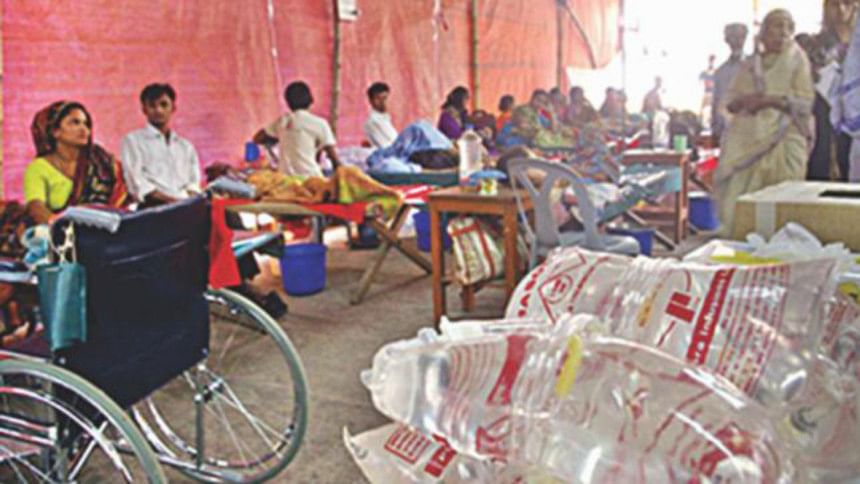Diarrhoeal disease treatment: Bangladesh’s celebrated success story

It'S a blistering afternoon in the nation's capital. Many are enjoying the change in weather from torrential downpour, but not 17-year-old Sonia Akhter (not her real name). She is hurriedly carried into the hospital by her father and elder brother. Sonia has been ill for the past three days, and she attributed her symptoms of abdominal cramps, nausea, fever, and watery stool to exam stress.
But then she took a turn for the worse when her fever rose and she started passing blood from her stool. By the time Sonia reached icddr,b's Dhaka hospital, she was so severely dehydrated, she could barely stand.
Once inside the hospital, she was immediately attended to by the physician on call who laid her down on one of the hospital's famous "diarrhoea cots" and given intravenous infusion fluids. Within a few hours, Sonia's condition significantly improved. She can now talk and move around, and she is escorted from the emergency ward to the general ward where she will continue her recovery.
Sonia could have been at death's door if she was left untreated, but was revived thanks to the IV fluids she was given, each bag containing a simple solution of water, sugar and salts (including electrolytes). This solution is called oral rehydration solution (ORS). Discovered in an attempt to meet the challenges of diarrhoeal disease globally, icddr,b's life-saving development of ORS and zinc therapy alone has saved an estimated 50 million lives worldwide over the last four decades—the majority of whom are children under-five. The British medical journal The Lancet has described ORS as "potentially the most important medical advance of this century".
After the ground-breaking discovery of ORS in the 1970s, BRAC (the world's largest NGO), supported by icddr,b, initiated a nationwide government-approved programme to raise awareness of diarrhoeal illness and teach caregivers how to make ORS at home. Oral rehydration solution was later commercially produced into packets by Social Marketing Company, the largest non-profit private social marketing company in Bangladesh, with support from USAID. The country now has the highest coverage of ORS use for treating diarrhoea, jumping from 50 percent in 1993 to more than 80 percent in 2011 for children under-five years of age.
icddr,b studies have also confirmed that the use of ORS to manage dehydrating diarrhoea has had a very substantial effect on reducing diarrhoeal mortality. In 2003, icddr,b initiated the Scaling Up Zinc for Young Children project based on its pioneering research on the protective effect of therapeutic zinc during childhood diarrhoea. The following year, WHO's new recommendation on diarrhoea management introduced the supplementation of zinc in addition to ORS.
Treatment of the disease only solves half the problem: prevention makes up the other half. With support from UNICEF, the government installed 10 million deep tube-wells free-of-cost in the 1970s to improve access to safe drinking water. From the 1990s, water, sanitation and hygiene (WASH) became an important priority and large-scale sanitation programmes were undertaken by both the public and NGO sectors.
The private sector was also engaged in the production of consumer-oriented latrines and tube-wells at affordable prices, which hastened the transition to safe drinking water consumption and hygienic sanitary practices (e.g. handwashing with soap). By 2014, the fruits of these initiatives were evident when almost every household in the country had access to safe drinking water along with a 45 percent increase in access to sanitary latrines.
In Bangladesh, the rate of under-five mortality from diarrhoea has decreased significantly from 15.1 per 1,000 live births to 6.0 between 1980 and 2015. In fact, diarrhoea killed nearly 560 per million people in the country as recently as 2003. But 10 years later, this number has been slashed to 145 per million—an impressive 95 percent reduction.
The primary factors associated with the decline in diarrhoea-related deaths for children under-five were ORS use, reduction of stunting and wasting prevalence, improving water, sanitation and handwashing with soap, and vitamin-A and zinc supplementation. This remarkable decline cannot be credited to one institution, but was achieved through concerted efforts by the Government of Bangladesh, local NGOs, private sector companies, and international partner organisations.
The success of these interventions has been made possible due to health system changes made by the government through timely adoption of evidence-based policies and programmes, as well as effective collaboration with the private sector and NGOs. If these partnerships continue to foster integrated approaches to tackling this disease, WHO's pledge to ending cholera by 2030 can be a reality and child deaths from diarrhoea can be drastically reduced by the upcoming decade.
Farasha Bashir, Communications Specialist, Communications at icddr,b.

 For all latest news, follow The Daily Star's Google News channel.
For all latest news, follow The Daily Star's Google News channel. 



Comments